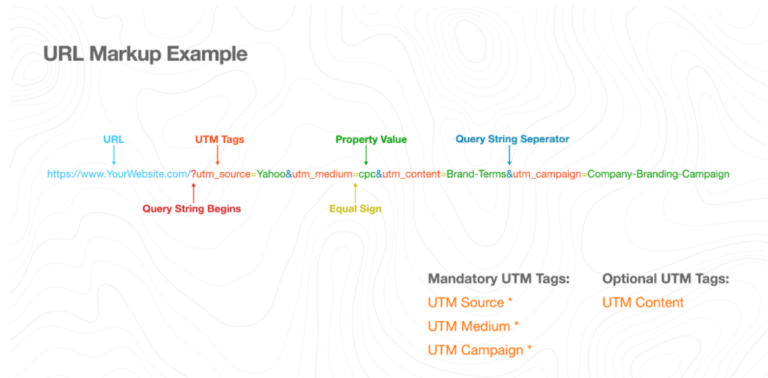Traffic arrives to your website from multiple internet sources and marketing channels. As a marketer, you want to know what tactics bring people and customers to your site. How do you get a good picture of what is going on?
For the most part, Google Analytics does a really good job segmenting traffic into specific traffic buckets or marketing channels. This classification is based on the source of that traffic and identifying characteristics of the ad or campaign. By default, Google Analytics groups all of your traffic and campaigns into nine “Channels.” Channels are a helpful way to get a clearer picture of how people get to your website and identify your most effective marketing campaigns.
Google Analytics: Default Channel Grouping
Direct: Visitors who typed in your website directly or bookmarked your website.
Organic Search: Visitors who used a search engine and clicked on an organic result (as opposed to a paid ad).
Paid Search: Visitors who used a search engine and clicked on a paid search result ad.
Display: Visitors that clicked on a display, banner, or content ad.
Social: Visitors who came from a site that Google identifies as social media, or from a campaign that has been tagged as social media through your campaign tracking.
Email: Visitors that come from a link that you identify as belonging to an email campaign.
Affiliates: Visitors that come from a link that you identify as belonging to an affiliate campaign.
Referral: Visitors that come from a website other than a search engine, display ad, social, email or affiliate. Common examples of these would be a blogger writing a review of your product and including a link, or coverage by a news outlet.
Other: Other advertising are campaigns Google does not identify as belonging to the other categories. This could be because they are special types of advertising campaigns like Cost per View, or more commonly, because campaign tracking was set up incorrectly.
You can see the specific rules Google uses for Default Channels in their support section here.
KEY POINTS
Sometimes Google Analytics will inappropriately group campaigns under the predefined Default Channel Groupings. As an internet marketer or web analyst you need to instruct Google Analytics how to classify this traffic. This is very easily achieved through the use of URL Query String Tags!
HOW TO IMPROVE URL QUERY STRING TAGS (UTM TAGS)
Google Analytics provides a great, simple, and functional tool to track all of your marketing campaigns by the appropriate channel. Tracking is achieved through appending URL query string tags to all marketing links back to your site (typically the homepage or landing pages) that you provide to off-site marketers or marketing channels.
Your website URL (web address) is made up of several sections. Google Analytics has special additional data in the form of query strings that do not affect your website performance but do pass data into Google Analytics to properly classify incoming traffic based on the type of campaign, source, and ad details.

All the parameters following the question mark ( ? ) in the above example are telling Google how to classify this ad and campaign.
CUSTOM UTM TRACKING PARAMETERS IN GOOGLE ANALYTICS
Maintaining good, consistent UTM tracking is key to good clean data. since many people may be applying tags, you need to create some guidelines. Tags are case sensitive so we recommend sticking to all lowercase letters.
UTM Source: Where is the traffic coming from. The source is specific, it should represent the website the ad or link was run(i.e. ebay). Examples:
yahoo
bing
commissionjunction
adRoll
youtube
facebook
for email, source can be a little tricky. Again, consistency is key. Most sites either use the email provider (ie mailchimp) as the source OR the mailing list (ie allcustomers). We prefer the later strategy because it gives you more insight!
UTM Medium: The marketing channel or strategy. A note that it is important as an organization to be consistent with these values and not use multiple names for the same strategy. We recommend managing a list of tactics and being cautious before adding new strategies. Examples:
cpc (paid search)
email
paid- social-ad
paid-social-boosted-post
affiliate
banner
retargeting
UTM Campaign: The name of the specific marketing campaign. As you cannot have spaces in these names, we recommend being consistent and using “-” to replace spaces. Examples:
fall-newsletter
winter-sale
top-product-banner-ads
cart-abandon-retargeting
branded-keyword-search
UTM Content: Specific links, ad, or creatives within a campaign
multiple-product-banner-ad
single-product-banner-ad
email-coupon-link
email-call-to-action-link
specific-product-link
keyword-ad-group
You should use this formatting and tracking tool to track and group all your incoming link traffic. This should be used for sources such as:
Display banner ads
Email marketing links
Affiliate marketing links
Paid Search on non-Google search engines such as Bing or Yahoo
Paid Social Media and sponsored posts on Linkedin, Facebook, Twitter, etc.
Re-targeting campaigns like AdRoll, PerfectAudience or SteelHouse
Vanity URLs like the ones used on billboards, magazine print ads or real estate listings
Promotional codes listed off-site on partner sites
Any marketing link you need to track as a campaign through a specified channel
USE THE GOOGLE ANALYTICS URL TRACKING TOOL:
Google has created a tool to help you better tag campaigns by filling in fields and letting Google generate the URL. When your URL has been generated, we still recommend checking for the following:
Only use one “?” (question mark)
Separate all query string parameters with an “&” (ampersand)
Within each query string parameter make sure there is an = (equal sign) after the UTM Tag
Make sure there are no spaces between words, use — (dashes) for spacing
Use consistent values for data you will want to be able to group, like UTM Medium (spelling and case matter)
Now go forth and make good data!

